
At D.S.S.I., Shihan Sensei DeValentino stresses Kyusho and Tuite, the striking and manipulation of vital points (pressure points) as part of a practical approach to self-defense. Kyusho and Tuite have been derived from the Chinese applications of Dim Mak and Chin Na which in turn are based on Traditional Chinese Medicine. A recognized authority on Dim Mak is Australian Taiji Master Erle Montaigue. Master Montaigue has dedicated the past eight years of his life to sharing the knowledge he acquired while studying with the Chinese masters on Mainland China. His comprehensive website at http://www.taijiworld.com stands as an excellent resource for the true student of martial arts.
The following information, derived from Master Montaigue's website, provides an overview of vital point/pressure point theory found in Traditional Chinese Medicine and its application in the martial arts. We humbly thank Master Montaigue for allowing us to share his copyrighted material on our website in an effort to help further the knowledge of martial artists everywhere. For the complete text of these notes and much more please visit http://www.taijiworld.com.
The meridians are related as follows:| Meridian | Element | Polarity |
| Lung | Metal | Yin |
| Colon (or Large Intestine) | Metal | Yang |
| Stomach | Earth | Yang |
| Spleen | Earth | Yin |
| Heart | Fire | Yin |
| Small Intestine | Fire | Yang |
| Bladder | Water | Yang |
| Kidney | Water | Yin |
| Pericardium | Fire | Yin |
| Triple Heater | Fire | Yang |
| Gall Bladder | Wood | Yang |
| Liver | Wood | Yin |
| YIN ORGANS | YANG ORGANS |
| Lung | Colon (or Large Intestine) |
| Spleen | Stomach |
| Heart | Small Intestine |
| Kidney | Bladder |
| Pericardium | Triple Heater |
| Liver | Gall Bladder |
| MERIDIAN | ALARM (MU) POINT | ASSOCIATED (SHU) POINT |
| LUNG | LU-1 | BL-13 |
| COLON (or Large Intestine) | ST-25 | BL-25 |
| STOMACH | CV-12 | BL-21 |
| SPLEEN | CO-13 | BL-20 |
| HEART | CV-14 | BL-15 |
| SMALL INTESTINE | CV-4 | BL-27 |
| BLADDER | CV-3 | BL-28 |
| KIDNEY | GB-25 | BL-23 |
| PERICARDIUM | CV-17 | BL-14 |
| TRIPLE HEATER | CV-24 | BL-22 |
| GALL BLADDER | GB-24 | BL-19 |
| LIVER | LIV-14 | BL-18 |
A description of the Units of Measurementmb Knuckle. Perhaps this is easier to understand. See measurement diagrams below:

Diagram 1

Diagram 2
How to Use the Guide
Simply click on a meridian in the index below to start your studies. Then as you read the guide you will notice that each point name in the text is hyperlinked. To see where the point is located, click on that hyperlink and you will be taken to a corresponding diagram. To return to you location in the text, simply use the back button on your browser.Index of Meridians